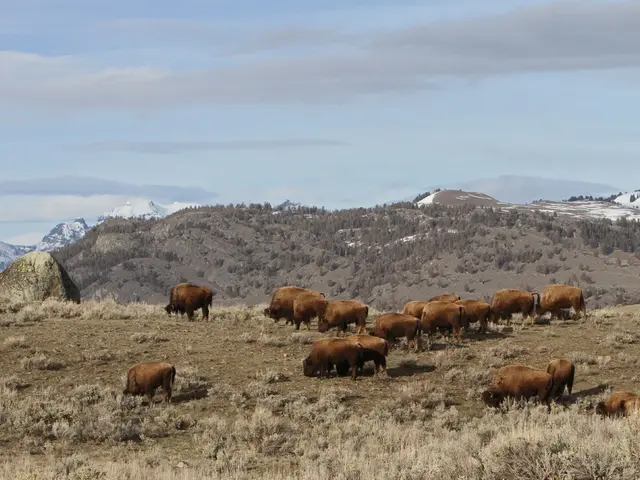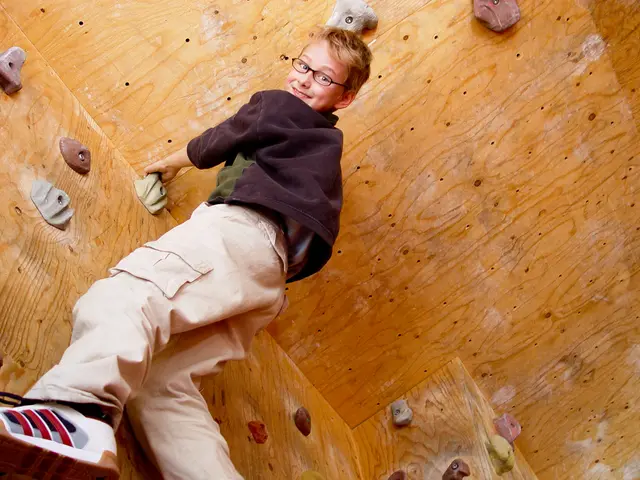Ten Outdoor Scavenger Hunts for Children Encouraging Seasonal Exploration and Awe
Gather your children and immerse them in nature with a seasonal scavenger hunt. Such outdoor explorations transform ordinary outings into enticing adventures, inspiring curiosity and learning.
Preparing for Your First Nature Adventure
Ensure a secure and educational experience by taking safety, gear, and rules into account.
Crucial Safety Measures
- Inform someone of your planned route and anticipated return time.
- Check the weather forecast and dress appropriately for the conditions.
- Carry a basic first aid kit, including bandages, insect bite cream, and antiseptic wipes.
- Keep youngsters within sight and establish clear boundaries for their movements.
- Teach them to avoid picking unknown plants, berries, or mushrooms.
- Equip them with enough water and sun protection, along with rain gear if necessary.
- Review fundamental outdoor rules, like staying on marked trails and keeping a charged cell phone available in case of emergencies.
- Carry collection containers, such as paper bags or small buckets.
- Bring along a printed scavenger hunt checklist featuring seasonal items.
- Include a magnifying glass for examining small nature specimens, a digital camera or smartphone for photo documentation, and a small notebook and pencil for sketching discoveries.
- Provide child-safe binoculars for sighting birds and wildlife, reusable bags for collecting litter (to instill conservation habits), suitable weather gear like hats, sunscreen, or rain jackets, simple field guides with pictures for identifying findings, and hand sanitizer and wet wipes for quick cleanups.
Exploring Spring's Natural Treasures
Tracking Early Spring Blooms
Look for delicate snowdrops peeking through melting snow in early March, bright yellow daffodils and purple crocuses in sunny spots, white trilliums and pink spring beauties beneath deciduous trees, and blue violets in partially shaded areas. Record blooming dates, take photos, and fashion pressed flower bookmarks from fallen petals.
Identifying Bird Nesting Materials
Watch for birds gathering twigs, dried grass, moss, strips of bark from cedar or birch trees, natural cotton or wool fibers, mud, spider webs, and dropped feathers. Spot water striders skating across puddle surfaces, tadpoles in longer-lasting puddles, mosquito larvae, small snails, and water beetles.
Discovering Summer's Outdoor Wonders
Searching for Vibrant Insects
In the summer, look for colorful creatures like dragonflies near water features, butterflies visiting flower gardens, busy bees pollinating blooms, ladybugs on leaves, and fireflies at dusk. Create an insect checklist for younger children with pictures, encouraging them to record their discoveries through sketches or photos.
Collecting Beach and Lake Findings
Investigate the shoreline to discover interesting treasures such as smooth beach glass in various colors, interesting shells washed up by the waves, pebbles with unique shapes, driftwood pieces, and seaweed varieties. Remember to collect only unoccupied shells and naturally discarded items, and bring small collection buckets.
Identifying Tree and Plant Species
Take advantage of summer foliage to learn tree and plant identification. Seek different leaf shapes like maple stars, oak lobes, and heart-shaped linden leaves, along with distinctive bark patterns such as shaggy hickory, diamond-patterned ash, and smooth beech bark. Encourage children to gather fallen leaves, create bark rubbings, and take photos for their nature journals.
Uncovering Fall's Hidden Gems
Leaf Hunting
Create an exciting leaf hunt, teaching kids to search for leaves in different fall colors, shapes, and sizes. Show them how to identify common trees like maple, oak, and birch through their distinctive leaf patterns. Foster interactive learning by having children sort leaves by color, size, or tree type and turn collected leaves into art projects by pressing them between wax paper or creating leaf rubbings with crayons.
Bird Watching
Set up a bird-watching station with binoculars and a simple identification guide to observe fall migration patterns. Watch for V-shaped formations of Canada geese heading south and other seasonal visitors like warblers and thrushes. Record each bird species spotted on a checklist, noting the date of observation. Create a bird-spotting map to track where different species appear in your area. Remember to stay quiet and still while watching to avoid startling the birds.
Forest Floor Discoveries
Explore the rich diversity of items scattered across the autumn forest floor. Find acorns, pinecones, seed pods, and various fungi varieties. Teach kids to identify edible nuts like chestnuts and walnuts, while explaining which ones to avoid. Create a collection box divided into sections for different types of finds. Use a magnifying glass to examine textures and patterns on bark pieces and fallen seeds.
Investigating Winter's Natural Elements
Animal Tracking
During winter walks, teach children to spot and identify animal tracks in snow or mud. Look for rabbit, deer, and bird tracks, and encourage children to photograph or sketch the tracks and measure their size using a ruler. Create a winter tracking journal to document which animals frequent the area during winter.
Exploring Evergreen Plants
Challenge kids to find plants that stay green throughout winter. Search for hardy evergreens like pine, spruce, and cedar trees, noting their different needle shapes and cone sizes. Examine winter-resistant ground covers such as holly, ivy, and wintergreen, which provide food for wildlife. Let kids collect fallen needles and cones to create nature-inspired winter crafts and learn about plant adaptations that help them survive cold temperatures.
Discovering Ice Formations
Guide children in exploring winter's most magical element—ice. Search for icicles hanging from tree branches, frost patterns on leaves, and frozen puddles that create natural mirrors. Investigate how water freezes in different shapes andInterface with icespeed up and push through soil, and encourage kids to document these frozen treasures with drawings or photographs while discussing the science behind ice formation.
Creating Educational Nature Collections
Transform your seasonal scavenger hunt finds into lasting educational displays, sparking ongoing curiosity and learning opportunities.
Setting Up Display Cases
Create dedicated display areas using clear plastic containers, mason jars, or shadow boxes to showcase nature treasures. Label each item with its common name, scientific name, and collection date. Organize collections by season, habitat, or type (leaves, rocks, shells, insects) to help children understand classification. Add small LED lights to highlight special specimens and rotate displays monthly to keep interest.
Making Nature Journals
Start each journal entry with the date, location, and weather conditions using a template that includes space for drawings, measurements, and observations. Encourage kids to sketch their findings, press flowers, or leaves, and note interesting details about color, texture, size, and shape. Include prompts such as "I wonder..." or "This reminds me of..." to develop scientific thinking skills. Add pocket folders to hold small flat specimens and photos of larger discoveries.
Incorporating Technology into Nature Hunts
Using Nature Apps
Turn your nature hunts into interactive learning experiences with identification apps such as iNaturalist or Seek. These apps allow kids to snap photos of discoveries and receive real-time species information including common names, scientific classification, and habitat details. Create digital nature collections by saving observations and tracking seasonal changes in your local area. Join projects like Nature's Notebook to participate in citizen science, allowing kids to contribute discoveries to real research projects.
Taking Wildlife Photos
Turn nature walks into photo safaris by teaching children basic wildlife photography skills using smartphones or kid-friendly cameras. Promote proper photography techniques such as staying still, being quiet, maintaining a safe distance from wildlife, and panning slowly when photographing moving creatures. Create a digital nature journal using photos organized by season, date, and location. Share exciting discoveries through family photo albums or supervised social media accounts designed for young naturalists like Kids for Nature.
Organizing Group Nature Hunt Events
Planning Neighborhood Hunts
Transform your local community into an exciting outdoor classroom by organizing group nature hunts for neighborhood kids. Create themed scavenger hunts based on local flora and fauna like "Native Bird Quest" or "Tree Treasure Hunt." Send digital invitations through neighborhood apps or community boards with clear meeting points, safety guidelines, and obscure clues. Set up collection stations at different houses where kids can gather, share discoveries, and exchange tips. Consider organizing post-hunt show-and-tell sessions to display findings.
Hosting School Nature Activities
Partner with teachers to integrate nature hunts into science curriculum, outdoor education programs, or extracurricular clubs. Design grade-specific hunts that align with learning objectives such as leaf classification for elementary students or ecosystem studies for middle schoolers. Create nature journals where students document their finds through sketches, observations, and field notes. Set up observation stations with magnifying glasses, field guides, and materials for identification. Incorporate STEM activities by having students measure, count, or graph their findings.
Teaching Environmental Stewardship
Learning Leave-No-Trace Principles
Teach children essential outdoor ethics through interactive scavenger hunt challenges, encouraging them to spot and understand responsible trail behavior, proper waste disposal, and safe walking paths. Award points for finding designated trails, spotting wildlife from a safe distance, and locating appropriate waste disposal areas.
Understanding Wildlife Protection
Transform wildlife observation into lessons about animal habitat preservation, instructing children to identify animal homes without disturbing them, spot evidence of wildlife from a safe distance, and record animal sightings in a nature journal. Teach them which plants serve as food sources for local animals and recognize warning signs of stressed wildlife.
Conclusion: Nourishing the Future Generation of Nature Enthusiasts
Seasonal nature scavenger hunts foster a sense of wonder, curiosity, and connection with the world around us. By combining outdoor exploration, learning, and safety, you provide memorable experiences that instill a lasting appreciation for nature. Whether tracking winter wildlife or collecting summer seashells, nurture your children's interest in the natural world and their commitment to environmental stewardship.
- Fashion a collection of seasonal treasures, labeling each item with its common name, scientific name, and collection date, to create a beautiful display for educational reference and ongoing curiosity.
- Encourage children's learning and self-development using nature photography, wildlife identification apps, and digital nature journals, contributing to citizen science projects and sharing discoveries with friends and family.
- Organize group nature hunts for neighborhood kids or school-based activities that inspire curiosity, instill good outdoor ethics, and encourage respect for wildlife and their habitats, thereby fostering a new generation of enthusiastic and knowledgeable nature lovers.







